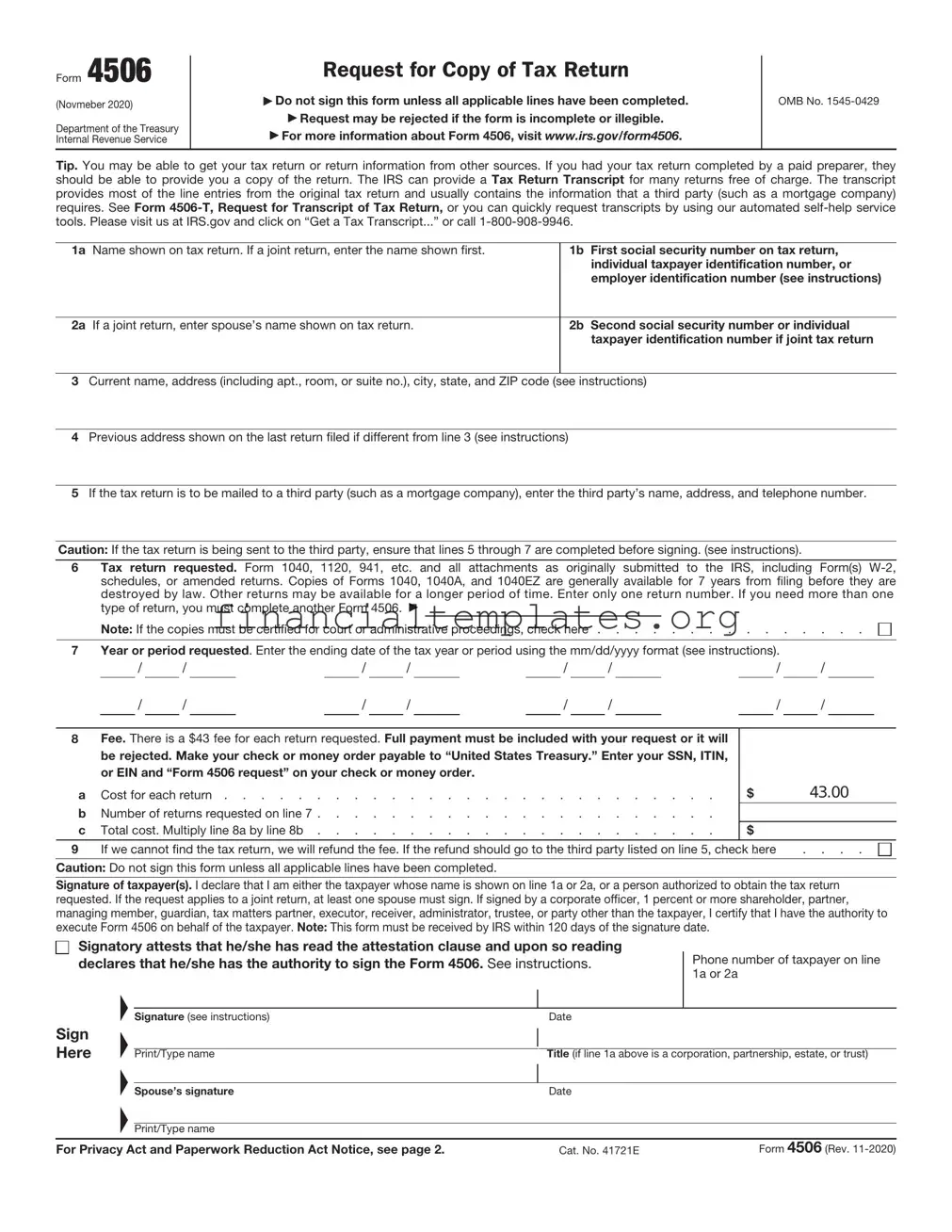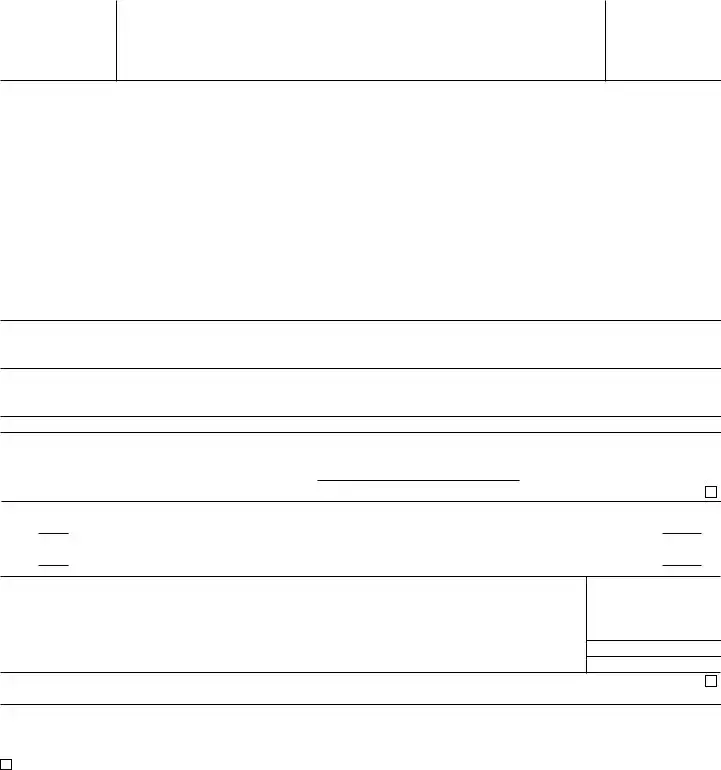Section references are to the Internal Revenue Code unless otherwise noted.
Future Developments
For the latest information about Form 4506 and its instructions, go to www.irs.gov/form4506.
General Instructions
Caution: Do not sign this form unless all applicable lines, including lines 5 through 7, have been completed.
Designated Recipient Notification. Internal Revenue Code, Section 6103(c), limits disclosure and use of return information received pursuant to the taxpayer’s consent and holds the recipient subject to penalties for any unauthorized access, other use, or redisclosure without the taxpayer’s express permission or request.
Taxpayer Notification. Internal Revenue Code, Section 6103(c), limits disclosure and use of return information provided pursuant to your consent and holds the recipient subject to penalties, brought by private right of action, for any unauthorized access, other use, or redisclosure without your express permission or request.
Purpose of form. Use Form 4506 to request a copy of your tax return. You can also designate (on line 5) a third party to receive the tax return.
How long will it take? It may take up to 75 calendar days for us to process your request.
Where to file. Attach payment and mail Form 4506 to the address below for the state you lived in, or the state your business was in, when that return was filed. There are two address charts: one for individual returns (Form 1040 series) and one for all other returns.
If you are requesting a return for more than one year or period and the chart below shows two different addresses, send your request based on the address of your most recent return.
Chart for individual returns (Form 1040 series)
If you filed an
individual return Mail to: and lived in:
|
Florida, Louisiana, |
|
|
Mississippi, Texas, a |
|
|
foreign country, American |
Internal Revenue Service |
|
Samoa, Puerto Rico, |
|
RAIVS Team |
|
Guam, the |
|
Stop 6716 AUSC |
|
Commonwealth of the |
|
Austin, TX 73301 |
|
Northern Mariana Islands, |
|
|
|
the U.S. Virgin Islands, or |
|
|
A.P.O. or F.P.O. address |
|
|
|
|
|
Alabama, Arkansas, |
|
|
Delaware, Georgia, |
|
|
Illinois, Indiana, Iowa, |
|
|
Kentucky, Maine, |
Internal Revenue Service |
|
Massachusetts, |
|
Minnesota, Missouri, |
RAIVS Team |
|
New Hampshire, New |
Stop 6705 S-2 |
|
Jersey, New York, North |
Kansas City, MO 64999 |
|
Carolina, Oklahoma, |
|
|
South Carolina, |
|
|
Tennessee, Vermont, |
|
|
Virginia, Wisconsin |
|
|
|
|
|
Alaska, Arizona, |
|
|
California, Colorado, |
|
|
Connecticut, District of |
|
|
Columbia, Hawaii, Idaho, |
Internal Revenue Service |
|
Kansas, Maryland, |
|
Michigan, Montana, |
RAIVS Team |
|
Nebraska, Nevada, New |
P.O. Box 9941 |
|
Mexico, North Dakota, |
Mail Stop 6734 |
|
Ohio, Oregon, |
Ogden, UT 84409 |
|
Pennsylvania, Rhode |
|
|
Island, South Dakota, |
|
|
Utah, Washington, West |
|
|
Virginia, Wyoming |
|
|
|
|
Chart for all other returns
For returns not in
Form 1040 series, Mail to: if the address on
the return was in:
Connecticut, Delaware, |
|
District of Columbia, |
|
Georgia, Illinois, Indiana, |
|
Kentucky, Maine, |
|
Maryland, |
|
Massachusetts, |
Internal Revenue Service |
Michigan, New |
RAIVS Team |
Hampshire, New Jersey, |
Stop 6705 S-2 |
New York, North |
Kansas City, MO |
Carolina, Ohio, |
64999 |
Pennsylvania, Rhode |
|
Island, South Carolina, |
|
Tennessee, Vermont, |
|
Virginia, West Virginia, |
|
Wisconsin |
|
|
|
Alabama, Alaska, |
|
Arizona, Arkansas, |
|
California, Colorado, |
|
Florida, Hawaii, Idaho, |
|
Iowa, Kansas, Louisiana, |
|
Minnesota, Mississippi, |
|
Missouri, Montana, |
|
Nebraska, Nevada, New |
|
Mexico, North Dakota, |
Internal Revenue Service |
Oklahoma, Oregon, |
RAIVS Team |
South Dakota, Texas, |
P.O. Box 9941 |
Utah, Washington, |
Mail Stop 6734 |
Wyoming, a foreign |
Ogden, UT 84409 |
country, American |
|
Samoa, Puerto Rico, |
|
Guam, the |
|
Commonwealth of the |
|
Northern Mariana |
|
Islands, the U.S. Virgin |
|
Islands, or A.P.O. or |
|
F.P.O. address |
|
Specific Instructions
Line 1b. Enter the social security number (SSN) or individual taxpayer identification number (ITIN) for the individual listed on line 1a, or enter the employer identification number (EIN) for the business listed on line 1a. For example, if you are requesting Form
1040 that includes Schedule C (Form 1040), enter your SSN.
Line 3. Enter your current address. If you use a P.O. box, please include it on this line 3.
Line 4. Enter the address shown on the last return filed if different from the address entered on line 3.
Note. If the addresses on lines 3 and 4 are different and you have not changed your address with the IRS, file Form 8822, Change of Address, or Form 8822-B,Change of Address or Responsible Party — Business, with Form 4506.
Line 7. Enter the end date of the tax year or period requested in mm/dd/yyyy format. This may be a calendar year, fiscal year or quarter. Enter each quarter requested for quarterly returns. Example: Enter 12/31/2018 for a calendar year 2018 Form 1040 return, or 03/31/2017 for a first quarter Form 941 return.
Signature and date. Form 4506 must be signed and dated by the taxpayer listed on line 1a or 2a. The IRS must receive Form 4506 within 120 days of the date signed by the taxpayer or it will be rejected. Ensure that all applicable lines, including lines 5 through 7, are completed before signing.
|
|
▲ |
You must check the box in the |
! |
signature area to acknowledge you |
have the authority to sign and request |
CAUTION |
the information. The form will not be |
processed and returned to you if the box is unchecked.
Individuals. Copies of jointly filed tax returns may be furnished to either spouse. Only one signature is required. Sign Form 4506 exactly as your name appeared on the original return. If you changed your name, also sign your current name.
Corporations. Generally, Form 4506 can be signed by: (1) an officer having legal authority to bind the corporation, (2) any person designated by the board of directors or other governing body, or (3) any officer or employee on written request by any principal officer and attested to by the secretary or other officer. A bona fide shareholder of record owning 1 percent or more of the outstanding stock of the corporation may submit a Form 4506 but must provide documentation to support the requester's right to receive the information.
Partnerships. Generally, Form 4506 can be signed by any person who was a member of the partnership during any part of the tax period requested on line 7.
All others. See section 6103(e) if the taxpayer has died, is insolvent, is a dissolved corporation, or if a trustee, guardian, executor, receiver, or administrator is acting for the taxpayer.
Note: If you are Heir at law, Next of kin, or Beneficiary you must be able to establish a material interest in the estate or trust.
Documentation. For entities other than individuals, you must attach the authorization document. For example, this could be the letter from the principal officer authorizing an employee of the corporation or the letters testamentary authorizing an individual to act for an estate.
Signature by a representative. A representative can sign Form 4506 for a taxpayer only if this authority has been specifically delegated to the representative on Form 2848, line 5a. Form 2848 showing the delegation must be attached to Form 4506.
Privacy Act and Paperwork Reduction Act Notice. We ask for the information on this form to establish your right to gain access to the requested return(s) under the Internal Revenue Code. We need this information to properly identify the return(s) and respond to your request. If you request a copy of a tax return, sections 6103 and 6109 require you to provide this information, including your SSN or EIN, to process your request. If you do not provide this information, we may not be able to process your request. Providing false or fraudulent information may subject you to penalties.
Routine uses of this information include giving it to the Department of Justice for civil and criminal litigation, and cities, states, the District of Columbia, and U.S. commonwealths and possessions for use in administering their tax laws. We may also disclose this information to other countries under a tax treaty, to federal and state agencies to enforce federal nontax criminal laws, or to federal law enforcement and intelligence agencies to combat terrorism.
You are not required to provide the information requested on a form that is subject to the Paperwork Reduction Act unless the form displays a valid OMB control number. Books or records relating to a form or its instructions must be retained as long as their contents may become material in the administration of any Internal Revenue law. Generally, tax returns and return information are confidential, as required by section 6103.
The time needed to complete and file Form 4506 will vary depending on individual circumstances. The estimated average time is: Learning about the law or the form, 10 min.; Preparing the form, 16 min.; and Copying, assembling, and sending the form to the IRS, 20 min.
If you have comments concerning the accuracy of these time estimates or suggestions for making Form 4506 simpler, we would be happy to hear from you. You can write to:
Internal Revenue Service
Tax Forms and Publications Division
1111 Constitution Ave. NW, IR-6526 Washington, DC 20224.
Do not send the form to this address. Instead, see Where to file on this page.


